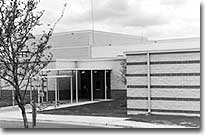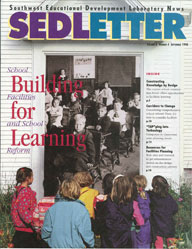TAPping into Technology
Gadsden Middle School is wired, ready, and waiting. The school's principal and district administrators are dedicated to getting teachers to use technology, many of the classrooms have computers, and technology and curriculum teams are in place. However, like many rural schools, this Anthony, NM school is awaiting e-rate funding and support from local telecommunications companies. Until then, the school has no Internet access.
Gadsden's situation is an example of one of the many challenges that schools and districts face once they decide to bring technology into the classroom.
The first challenges schools and districts encounter are most likely those related to facilities planning. The facilities issues may range from inadequate electrical wiring and outlets, to wiring for networks, to having sufficient space for a computer lab, or making room for one or more computers in a 700-square-foot classroom already crowded with 22 students.
Raising money for technology investment is a primary concern, of course, with some administrators resorting to general obligation bonds to get the necessary capital. Others, like principal Claudia Tousek at Bernice Hart Elementary in Austin, discover they must network and pool resources to get the technology-rich environment they want for their schools. At Hart there are multiple computers in each classroom. Each classroom also has a direct Internet connection and global email. Each teacher has a phone with voicemail, and the classes have access to laser printers, LCD projectors, scanners, camcorders, and digital cameras. To obtain the level of technology she envisioned, Tousek planned a technology program that relies on Apple Computers, the RGK Foundation, and SEDL for external assistance.
As daunting as obtaining the financial resources may be, the real challenge comes after a school has computers. As many educators and administrators have found, it is one thing to put a computer in every classroom, but quite another to bring the world to the classroom through technology.
Not only does the latter require more careful facilities planning and investment in modems and Internet access, but most importantly, integrating the technology into instruction in a meaningful way. And perhaps this is what frustrates Gadsden Middle School most about not having Internet access. Twenty-nine teachers at the school have already started training to incorporate technology into their curricula by participating in SEDL's "Applying Technology to Restructuring and Learning" project through the Technology Assistance Program (TAP).

Bernice Hart Elementary School in northeast Austin, Texas.
SEDL program specialist Jackie Burniske says the two-year project will train teachers to work in a student-centered way. "We're showing teachers how to integrate technology into a theme-based curriculum, how to apply technology to restructure learning," she says. "We model a student-centered classroom for the teachers where students are engaged and the teacher works as a facilitator."
Thinking of schools as places where knowledge is actively built - as knowledge construction organizations - is key to our information and technology age, according to Professor Francis P. Hunkins of the University of Washington's Department of Curriculum and Instruction. He says, "Knowledge which is obtained from processing information is the new economic, social, and political capital of this new age."
Technology is a wonderful tool for helping students construct knowledge, but only one-fifth of teachers nationwide use computers in teaching. Many teachers have received no training on using computers in the classroom and much of the training they have received deals with using specific software packages. SEDL's professional development goes beyond that.
The SEDL team models activities that teachers can take back to the classroom and works with teachers to incorporate technology into lesson plans.

Teachers at the newly-built Bernice Hart Elementary School get ready for the school year with hands-on training from SEDL's Technology Assistance Program.
The team conducts formal professional development sessions with 25 to 30 faculty members at each of the schools six times during the first year of the project. In addition to these scheduled sessions, team members will work with individual teachers between sessions, observe classrooms, discuss issues on the project's electronic bulletin board, and model activities with students at the schools.
The teachers adopt constructivist methods and use technology at their own rates, however. Burniske notes, "It is up to the teachers what steps they will take to implement what they learn during professional development."
"We know that changing teaching practices requires on-going support and assistance," says program manager Vicki Dimock. "Our aim is to build capacity at each site to improve learning by supporting a community of teachers who have confidence using technological tools."
Each site has at least one participant who will work with SEDL staff in the design and presentation of the staff development. This "master trainer" will then provide on-going support to the teachers participating in the project and teach others how to incorporate technology into the classroom.
The local support is important because the technology and learning environments in place at the participating schools are as diverse as the cultures of the areas where they are located. Program associate Mary Burns, who is working with Carencro Middle School in Carencro, Louisiana, in the heart of Acadiana, says that although most of the teachers there teach in very traditional ways, the school is "really eager to integrate technology in a student-centered way." About half of the classroom teachers at the school are participating in the program and these 25 are getting computers in their classrooms.
In Pocahontas, Arkansas, program specialist Sharon Adams is working at a school that already has a good technology infrastructure. When pocahontas High School served as a pilot school with the Arkansas Public School Computer Network in 1993, a group of dedicated teachers, community volunteers, and students helped build the school's network, initially linking 19 computers to the Internet. That beginning effort has grown to a systemwide network that provides Internet access to teachers throughout the district. Adams observes that there are a few stellar examples of technology integration at the school, including Ivy Pfeffer's Spanish classroom which connects and converses with other foreign language students via the classroom's CU-SeeMe camera.

When students at Carencro Middle School, Carencro, Louisiana, return to school this fall, they will find many of their teachers integrating technology into their lesson plans.
Program associate Jim Zuhn is working with a consortium of five schools in Cherokee County, Oklahoma. Although these schools have relatively small student populations, all have already been networked or are in the process of being networked. Most have a computer in every classroom and at least one computer lab for the entire school. Zuhn reports that all of these schools are very open to new methodologies and paradigms. "They are very innovative people, making good use of their resources," he notes.
Local universities are involved with the "Applying Technology to Restructuring Learning" project, too. Although the university representatives are working with the schools in a variety of ways, they will carry project activities and ideas to other schools in their communities. "This is another way of local capacity building," acknowledges Burns.
The Technology Assistance Program includes a web site now under construction and an electronic bulletin board so that participating schools can communicate with each other on-line. The program has produced a video that demonstrates classroom activities: "Engaged Discoverers: Kids Constructing Knowledge with Technology" will soon be available from SEDL. The project is also creating a professional development portfolio and descriptions of the technology integration models used in classrooms at the site schools for others interested in setting up a similar program. Professional development such as that provided by TAP can transform technology from a facilities-equipment issue to a curriculum issue. With proper teacher training and interactive projects, technology can become the effective teaching tool lit should be
"The participants understand that putting a computer in every classroom is not a panacea for improving teaching and learning," says program associate Marilyn Heath, who is working with Gadsden. "TAP is providing a process for helping them move along that path."
Next Article: Resources for Facilities Design and Planning

